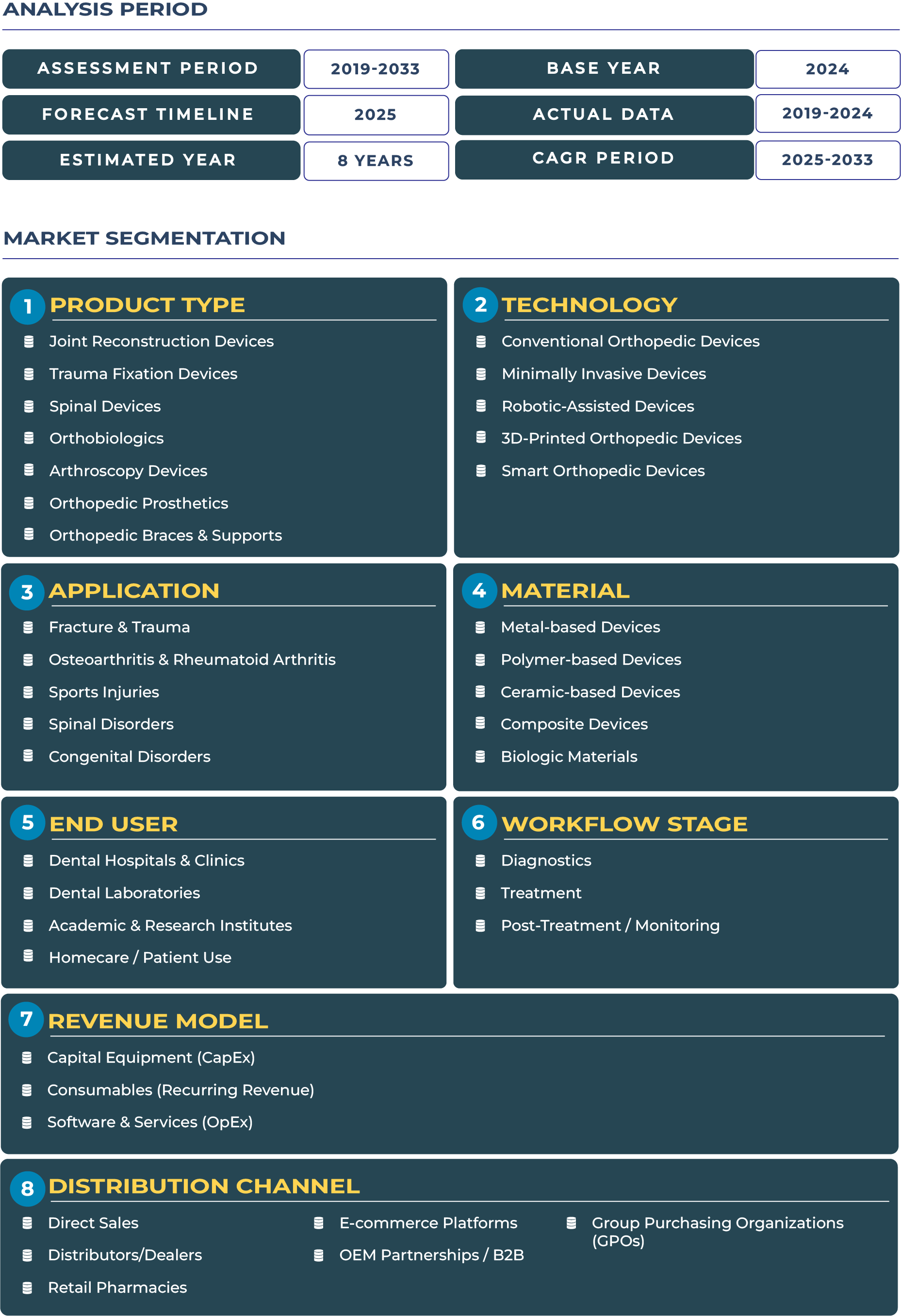Report Format:
![]()
![]() |
Pages: 110+
|
Pages: 110+
Taiwan’s Digital-Driven Orthopedic Devices Market: A Precision-Oriented Growth Path
Taiwan has established itself as a hub of digital healthcare innovation, and its orthopedic devices industry reflects this maturity. With robust adoption of smart healthcare technologies, Taiwan is leveraging precision-driven solutions to transform orthopedic care. The orthopedic devices market in Taiwan is projected to grow from USD 482.6 million in 2025 to USD 648.5 million by 2033. This moderate but consistent growth is supported by a well-structured healthcare system, strong medical device R&D capabilities, and widespread integration of digital health platforms. The market performance is a reflection of Taiwan’s ability to maintain affordability while advancing innovation in implants, trauma fixation devices, and orthopedic prosthetics, creating an ecosystem where both domestic patients and international partners benefit from technology-led healthcare.
How Digital Precision and Innovation are Redefining Orthopedic Care in Taiwan
The orthopedic devices sector in Taiwan is entering a phase of stability, where innovation rather than volume expansion drives progress. A mature healthcare infrastructure, coupled with significant investments in digital health, enables the sector to prioritize precision-driven devices and personalized medicine. The integration of robotics in joint reconstruction, AI-assisted imaging for spinal care, and advanced biologics for trauma healing exemplify this forward-looking approach. Rising life expectancy, growing demand for minimally invasive procedures, and Taiwan’s medical education ecosystem further reinforce the market’s prospects. However, given Taiwan’s relatively smaller population size compared to regional peers, the growth trajectory emphasizes quality and high-value exports rather than sheer domestic volume. This balance of stability and innovation ensures that Taiwan Orthopedic Devices industry remains globally competitive while meeting local needs effectively.
Drivers & Restraints: Key Growth Catalysts and Market Barriers in Taiwan Orthopedic Devices Sector
Driving Forces Empowering Market Expansion: Taiwan Orthopedic Devices market benefits from a confluence of structural strengths. High clinician specialization, supported by world-class training at institutions linked with the Ministry of Health and Welfare, ensures a steady pool of skilled orthopedic surgeons and specialists. In addition, the island’s strong medtech R&D foundation fosters collaborations between universities and manufacturers, encouraging the development of advanced implants and customized prosthetics. Stable reimbursement policies further strengthen adoption, ensuring patients have access to both innovative and essential devices without prohibitive costs. Such factors allow Taiwan to build a healthcare ecosystem that integrates cutting-edge solutions into mainstream clinical workflows.
Restraining Factors Hampering Industry Scale-Up: Despite its strengths, Taiwan faces structural limitations in scaling its orthopedic devices industry. The relatively small domestic patient base makes it challenging for companies to achieve economies of scale. Government price containment policies, while ensuring affordability, restrict premium pricing for advanced implants and orthobiologics. Additionally, the export-oriented focus of local manufacturers often results in prioritization of overseas markets at the expense of domestic availability. Workforce distribution challenges, with highly skilled professionals concentrated in Taipei and major cities, also create unequal access across regions. These constraints underline the importance of a balanced approach that promotes both export competitiveness and local healthcare access.
Trends & Opportunities: Emerging Shifts Shaping Taiwan Orthopedic Devices Ecosystem
Trend: Focus on High-Value Innovation and Export Competitiveness Taiwan Orthopedic Devices landscape is marked by its emphasis on high-value, differentiated products. The rise of robotics in arthroscopy, precision spinal implants tailored to patient-specific anatomy, and bio-absorbable trauma fixation devices highlight the industry’s transition toward next-generation care solutions. Furthermore, Taiwan’s reputation as a medtech exporter continues to expand, with its orthopedic products gaining traction in Southeast Asia and the Middle East. Private clinics are also emerging as key growth hubs, offering advanced orthopedic treatments to affluent patients seeking specialized care outside of public hospital systems.
Opportunity: Leveraging Digital Co-Development and Precision Medicine Taiwan has a unique opportunity to strengthen its orthopedic devices market by focusing on co-development projects with global OEMs and fostering niche export plays. The integration of precision medicine principles, including genomic profiling to optimize orthopedic implant compatibility, opens new avenues for product differentiation. Affordable premium implant lines designed specifically for regional export markets could further enhance competitiveness. In addition, surgeon training programs linked to smart device adoption can accelerate the transition toward digital-first orthopedic care. Cities like Taipei and Taichung, with their strong hospital networks, provide fertile ground for piloting such innovations.
Competitive Landscape: Strategic Moves Reshaping Taiwan Orthopedic Devices Industry
The competitive dynamics of Taiwan Orthopedic Devices sector combine both global leaders and innovative local firms. Companies such as Medtronic actively collaborate with Taiwanese hospitals to introduce advanced minimally invasive spinal solutions, while local players leverage their R&D edge to co-develop premium implants. Strategies such as co-developing niche products with local partners, targeting high-value export markets, and sponsoring clinical trials led by key opinion leaders are gaining prominence. For instance, local orthopedic startups are increasingly engaging with Taiwan’s strong academic ecosystem to create export-ready biologics and smart implants. These strategies underline Taiwan’s role as both an innovator and a strategic partner in the global orthopedic devices ecosystem.







